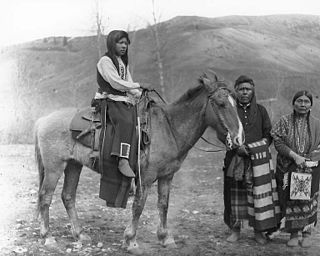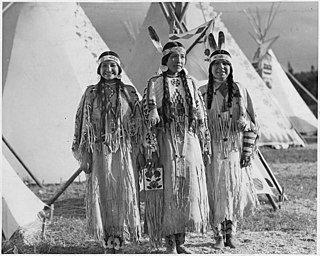Related Research Articles

The Nez Perce are an Indigenous people of the Plateau who still live on a fraction of the lands on the southeastern Columbia River Plateau in the Pacific Northwest. This region has been occupied for at least 11,500 years.

Hin-mah-too-yah-lat-kekt, popularly known as Chief Joseph, Young Joseph, or Joseph the Younger, was a leader of the wal-lam-wat-kain (Wallowa) band of Nez Perce, a Native American tribe of the interior Pacific Northwest region of the United States, in the latter half of the 19th century. He succeeded his father tuekakas in the early 1870s.
A vision quest is a rite of passage in some Native American cultures. It is usually only undertaken by young males entering adulthood. Individual Indigenous cultures have their own names for their rites of passage. "Vision quest" is an English-language umbrella term, and may not always be accurate or used by the cultures in question.

The Palouse are a Sahaptin tribe recognized in the Treaty of 1855 with the United States along with the Yakama. It was negotiated at the 1855 Walla Walla Council. A variant spelling is Palus. Today they are enrolled in the federally recognized Confederated Tribes and Bands of the Yakama Nation and some are also represented by the Colville Confederated Tribes, the Confederated Tribes of the Umatilla Indian Reservation and Nez Perce Tribe.
The Spokan or Spokane people are a Native American Plateau tribe who inhabited the eastern portion of present-day Washington state and parts of northern Idaho in the United States of America.
Harley "Swiftdeer" Reagan (1941–2013) was an American pretendian and new age spiritual leader. He is known for founding the Deer Tribe Metis Medicine Society and for developing Chulukua, a martial art, and Chuluaqui Quodoushka, a collection of sexual techniques and theories.
Plastic shamans, or plastic medicine people, is a pejorative colloquialism applied to individuals who are attempting to pass themselves off as shamans, holy people, or other traditional spiritual leaders, but who have no genuine connection to the traditions or cultures they claim to represent. In some cases, the "plastic shaman" may have some genuine cultural connection, but is seen to be exploiting that knowledge for ego, power, or money.
Since the early 1970s, a legend of Rainbow Warriors has inspired some environmentalists and hippies with a belief that their movement is the fulfillment of a Native American prophecy. Usually the "prophecy" is claimed to be Hopi or Cree. However, this "prophecy" is not Native American at all, but rather from a 1962 Evangelical Christian religious tract, titled Warriors of the Rainbow by William Willoya and Vinson Brown from Naturegraph Publishers. Brown is also the founder and owner of Naturegraph Publishers. Discussing the legend, scholar Michael Niman said, "If anything, it was an attack on Native culture. It was an attempt to evangelize within the Native American community."

The Sahaptin are a number of Native American tribes who speak dialects of the Sahaptin language. The Sahaptin tribes inhabited territory along the Columbia River and its tributaries in the Pacific Northwest region of the United States. Sahaptin-speaking peoples included the Klickitat, Kittitas, Yakama, Wanapum, Palus, Lower Snake, Skinpah, Walla Walla, Umatilla, Tenino, and Nez Perce.

Weippe Prairie is a "beautiful upland prairie field of about two by three miles bordered by farmland made from cleared pine forests" at 3,000 feet elevation in Clearwater County, Idaho, at Weippe, Idaho. Camas flowers grow well there, and attracted native gatherers of the camas roots. It is the location in Idaho where the Lewis and Clark Expedition emerged from crossing the Bitterroot Mountains on the Lolo Trail and first met the Nez Perce tribe of Native Americans.

Traditional gender roles among Native American and First Nations peoples tend to vary greatly by region and community. As with all Pre-Columbian era societies, historical traditions may or may not reflect contemporary attitudes. Gender roles exhibited by Indigenous communities have been transformed in some aspect by Eurocentric, patriarchal norms and the perpetration of systematic oppression. In many communities, these things are not discussed with outsiders.
The red road is a modern English-language concept of the right path of life, as inspired by some of the beliefs found in a variety of Native American spiritual teachings. The term is used primarily in the Pan-Indian and New Age communities, and rarely among traditional Indigenous people, who have terms in their own languages for their spiritual ways. Native Americans' spiritual teachings are diverse. With over 500 federally-recognized tribes in just the US, while some regional practices and beliefs might be similar, the cultures are highly individualized. Individual ceremonies and particular beliefs tend to be unique to the people of these diverse bands, tribes and nations.

Two-spirit is a modern, pan-Indian umbrella term used by some Indigenous North Americans to describe Native people in their communities who fulfill a traditional third-gender ceremonial and social role in their cultures.

Yellow Wolf or He–Mene Mox Mox was a Nez Perce warrior who fought in the Nez Perce War of 1877. In his old age, he decided to give the war a Native American perspective. From their meeting in 1907 till his death in 1935, Yellow Wolf talked annually to Lucullus Virgil McWhorter, who wrote a book for him, Yellow Wolf: His Own Story. He is notable as one of the few members of the defeated Nez Perce to talk openly to strangers and tell their story to the world.

Shaking tent ceremony is a ritual of some of the indigenous people in North America that is used to connect the people with the spirit realm and establish a connection and line of communication between the spirit world and the mortal world. These ceremonies require special tents or lodges to be made, and are performed under the direction of a shaman, or spiritual leader, who uses different practices, rituals, and materials to perform the ceremony. This ceremony is more commonly used by specific indigenous tribes long ago but is still practiced around the continent today.
Pretendian is a pejorative colloquialism used to call out a person who has falsely claimed Indigenous identity by professing to be a citizen of a Native American or Indigenous Canadian tribal nation, or to be descended from Native American or Indigenous Canadian ancestors. As a practice, being a pretendian is considered an extreme form of cultural appropriation, especially if that individual then asserts that they can represent, and speak for, communities from which they do not originate. It is sometimes also referred to as a form of fraud, ethnic fraud or race shifting.
References
- 1 2 3 4 Anderson, Lorraine, ed. (2003). Sisters of the Earth: Women's Prose and Poetry About Nature. Vintage Books. ISBN 9781400033218.
- 1 2 Sallquist, Bill (October 29, 1981). "Medicine Woman Blends Treatments". Spokane Daily Chronicle – via Google News.
- ↑ "About Brooke Medicine Eagle". MedicineEagle.com. Archived from the original on October 25, 2014. Retrieved March 20, 2013.
She has ancestors in six native tribes (Crow, Nez Perce, Lakota, Cree, Peigan and Cherokee) as well as European blood from Scotland, Ireland, and Denmark.
- 1 2 Grimes, Ronald L. (2002). Deeply Into the Bone: Re-Inventing Rites of Passage. University of California Press. p. 143. ISBN 9780520236752.
- ↑ Snavely, Cynthia A. (2001). "Native American Spirituality: Its Use and Abuse by Anglo-Americans". Journal of Religious & Theological Information . 4 (1): 91–103. doi:10.1300/J112v04n01_08. S2CID 216086951.
- ↑ Center for the SPIRIT. "Alert – Re:Brooke 'Medicine Eagle' Edwards". Sonoma County Free Press. Archived from the original on March 1, 2003. Retrieved December 20, 2023.
- ↑ "An Evening With CocoRosie". DoTheBay . October 28, 2013. Retrieved May 7, 2021.